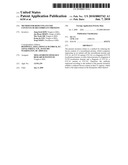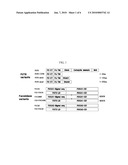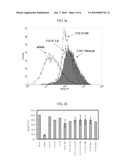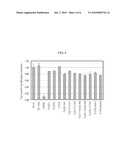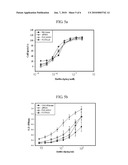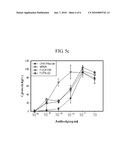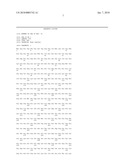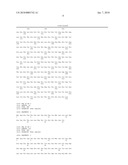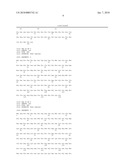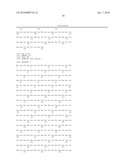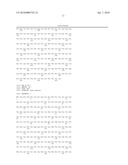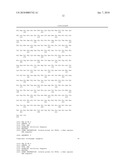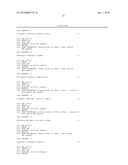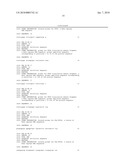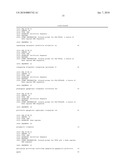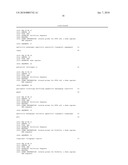Patent application title: METHOD FOR REDUCING FUCOSE CONTENTS OF RECOMBINANT PROTEINS
Inventors:
Jung-Seob Kim (Yongin-Si, KR)
Jae-Hoon Moon (Gunpo-Si, KR)
Mee Sook Oh (Yongin-Si, KR)
Kong Ju Lee (Yongin-Si, KR)
Yeup Yoon (Gwacheon-Si, KR)
Assignees:
Mogam Biotechnology Research Institute
IPC8 Class: AC07K114FI
USPC Class:
435272
Class name: Process of utilizing an enzyme or micro-organism to destroy hazardous or toxic waste, liberate, separate, or purify a preexisting compound or composition therefore; cleaning objects or textiles treating animal or plant material or micro-organism proteinaceous material recovered or purified
Publication date: 2010-01-07
Patent application number: 20100003742
Claims:
1. A method for reducing the fucose content of a recombinant protein,
which comprises expressing in an animal cell the recombinant protein and
one or more proteins selected from the group consisting of:a) FUCA1
having the amino acid sequence of SEQ ID NO: 6;b) an FUCA1 mutant having
an amino acid sequence obtained by replacing asparagine of the amino acid
sequence of FUCA1 with other amino acid;c) FUCA2 having the amino acid
sequence of SEQ ID NO: 7; andd) a fragment of the localization domain of
FUT8 having the amino acid sequence of SEQ ID NO: 1.
2. The method of claim 1, wherein the recombinant protein is a glycoprotein having alpha-1,6-fucose.
3. The method of claim 2, wherein the alpha-1,6-fucose exists on the N-acetylglucosamine reducing sugar terminal of the glycoprotein's carbohydrate moiety.
4. The method of claim 1, wherein the recombinant protein is an antibody.
5. The method of claim 4, wherein the fucose content of the antibody is reduced to elevate the therapeutic effect of the antibody.
6. The method of claim 1, wherein the animal cell is first transfected with an expression vector for the recombinant protein and then one or more proteins selected from the group consisting of a) to d) are expressed therein.
7. The method of claim 1, wherein an expression vector for the recombinant protein is introduced into the animal cell after expressing one or more proteins selected from the group consisting of a) to d) in the animal cell.
8. The method of claim 1, wherein the fragment of FUT8 localization domain has an amino acid sequence composed of the 1.sup.st to nth amino acids of FUT8 having the amino acid sequence of SEQ ID NO: 1, n being an integer ranging from 30 to 200.
9. The method of claim 8, wherein n is 30 and the fragment of FUT8 localization domain has the amino acid sequence of SEQ ID NO: 2.
10. The method of claim 8, wherein n is 125 and the fragment of FUT8 localization domain has the amino acid sequence of SEQ ID NO: 4.
11. The method of claim 8, wherein n is 200 and the fragment of FUT8 localization domain has the amino acid sequence of SEQ ID NO: 5.
12. The method of claim 1, wherein the FUCA1 mutant has the amino acid sequence obtained by replacing the 263.sup.rd asparagine of FUCA1 having the amino acid sequence of SEQ ID NO: 6 with valine.
13. The method of claim 1, wherein the animal cell is selected from the group consisting of cells of CHO (Chinese hamster ovary), rat myeloma, BHK (baby hamster kidney), hybridoma, Namalwa, embryonic stem and fertilized egg.
14. The method of claim 1, wherein the procedure of expressing one or more of the proteins a) to d) is conducted by introducing into the animal cell i) a recombinant vector comprising a DNA encoding the proteins or recombinant vectors each comprising a DNA encoding any one of the proteins a) to d).
15. A method for reducing the fucose content of a recombinant protein, which comprises expressing in an animal cell the recombinant protein and a fusion protein obtained by fusing a fragment of the localization domain of FUT8 having the amino acid sequence of SEQ ID NO: 1 with a protein selected from the group consisting of:a) a fragment of FUCA1, which has the amino acid sequence obtained by deleting 1.sup.st to 26.sup.th amino acids of the amino acid sequence of SEQ ID NO: 6;b) a fragment of FUCA2, which has the amino acid sequence obtained by deleting 1.sup.st to 28.sup.th amino acids of the amino acid sequence of SEQ ID NO: 7; andc) a mutant of FUCA1 fragment, which has the amino acid sequence obtained by replacing asparagine of the amino acid sequence of the fragment of FUCA1 with other amino acid.
16. The method of claim 15, wherein the recombinant protein is a glycoprotein having alpha-1,6-fucose.
17. The method of claim 16, wherein the alpha-1,6-fucose exists on the N-acetylglucosamine reducing sugar terminal of the glycoprotein's carbohydrate moiety.
18. The method of claim 15, wherein the recombinant protein is an antibody.
19. The method of claim 18, wherein the fucose content of the antibody is reduced to elevate the therapeutic effect of the antibody.
20. The method of claim 15, wherein the animal cell is first transfected with an expression vector for the recombinant protein and then one or more proteins selected from the group consisting of a) to c) are expressed therein.
21. The method of claim 15, wherein an expression vector for the recombinant protein is introduced into then animal cell after expressing the fusion protein of the fragment of FUT8 localization domain and a fragment selected from the group consisting of a) to c) in the animal cell.
22. The method of claim 15, wherein the fragment of FUT8 localization domain has an amino sequence composed of 1.sup.st to nth amino acids of FUT8 having the amino acid sequence of SEQ ID NO: 1, n being an integer ranging from 30 to 200.
23. The method of claim 22, wherein n is 30 and the fragment of FUT8 localization domain has the amino acid sequence of SEQ ID NO: 2.
24. The method of claim 22, wherein n is 101 and the fragment of FUT8 localization domain has the amino acid sequence of SEQ ID NO: 3.
25. The method of claim 22, wherein n is 125 and the fragment of FUT8 localization domain has the amino acid sequence of SEQ ID NO: 4.
26. The method of claim 22, wherein n is 200 and the fragment of FUT8 localization domain has the amino acid sequence of SEQ ID NO: 5.
27. The method of claim 15, wherein the mutant of FUCA1 fragment has the amino acid sequence obtained by replacing the 263.sup.rd asparagine with valine and deleting 1.sup.st to 26.sup.th amino acids from the amino acid sequence of SEQ ID NO: 6.
28. The method of claim 15, wherein the fusion protein is a protein prepared by fusing a fragment of FUT8 localization domain having the amino acid sequence of SEQ ID NO: 3 with a fragment of FUCA1 having the amino acid sequence obtained by deleting 1.sup.st to 26.sup.th amino acids from the amino acid sequence of SEQ ID NO: 6.
29. The method of claim 15, wherein the fusion protein is a protein prepared by fusing a fragment of FUT8 localization domain having the amino acid sequence of SEQ ID NO: 3 with a fragment of FUCA2 having the amino acid sequence obtained by deleting 1.sup.st to 28.sup.th amino acids from the amino acid sequence of SEQ ID NO: 7.
30. The method of claim 15, wherein the fusion protein is a protein prepared by fusing a fragment of FUT8 localization domain having the amino acid sequence of SEQ ID NO: 2 with a mutant of FUCA1 fragment having the amino acid sequence obtained by replacing the 263.sup.rd asparagine with valine and deleting 1.sup.st to 26.sup.th amino acids from the amino acid sequence of SEQ ID NO: 6.
31. The method of claim 15, wherein the fusion protein is a protein prepared by fusing a fragment of FUT8 localization domain having the amino acid sequence of SEQ ID NO: 3 with a mutant of FUCA1 fragment having the amino acid sequence obtained by replacing the 263.sup.rd asparagine with valine and deleting 1.sup.st to 26.sup.th amino acids from the amino acid sequence of SEQ ID NO: 6.
32. The method of claim 15, wherein the animal cell is selected from the group consisting of cells of CHO (Chinese hamster ovary), rat myeloma, BHK (baby hamster kidney), hybridoma, Namalwa, embryonic stem and fertilized egg.
33. The method of claim 15, wherein the procedure of expressing the fusion protein is conducted by introducing into the animal cell i) a recombinant vector comprising a DNA encoding the fusion proteins or ii) recombinant vector each comprising a DNA encoding anyone of the fusion proteins.
Description:
CROSS REFERENCE TO RELATED APPLICATIONS
[0001]This application claims priority from Korean patent application No. 10-2008-0064483 filed on Jul. 3, 2008, all of which is incorporated herein by reference in its entirety for all purposes.
FIELD OF THE INVENTION
[0002]The present invention relates to a method for reducing the fucose content of a recombinant protein, which comprises expressing in an animal cell the recombinant protein and FUCA1, an FUCA1 mutant, FUCA2, or a fragment of FUT8 localization domain; or with a fusion protein of a fragment of FUT8 localization domain and a fragment of FUCA1, a FUCA1 mutant or FUCA2.
BACKGROUND OF THE INVENTION
[0003]With the completion of human genome project and the identification of numerous disease-related genes through post-genomic approaches, therapeutic protein research has undergone an enormous progress. Most therapeutic proteins are glycoproteins whose therapeutic effects had been previously known to be affected only by their amino acid sequences. However, it has recently been established that the activity of a therapeutic protein can be effectively improved by modifying the sugar chain attached thereto, and such a sugar chain has been reported to be involved in variable biological functions including organogenesis, aging, infection, inflammation, biodefense, oncogenesis, cancer metastasis, tissue degeneration, regeneration and apoptosis. Glycomics is a glyco-engineering technology devoted to improve the therapeutic effect of conventional medicines by modifying its sugar chain so as to elevate both the activity and the stability, and also to minimize the effective dose and the adverse effects of them.
[0004]After the introduction in 1986 by Ortho Biotech Inc. of the first therapeutic antibody `OKT3`, a murine-derived antibody for the treatment of kidney transplant rejection, Centocor Inc. has developed `Reopro` for inhibiting a platelet aggregation and `Remicade` for treating Crohn's disease in 1994; and Genentech Inc., `Herceptin` for treating breast cancer and `Rituxan` for treating non-Nodgkins lymphoma (NHL). The development of the therapeutic antibody has been pursued in the fields of (i) technologies for the construction of chimeric, humanized and human antibodies (Jain, M. et al., Trend in Biotechnology, 25(7), 307-316, 2007), (ii) technologies for increased therapeutic effects of antibodies using Fc engineering (Lazar, G. A. et al., PNAS, 103(11), 4005-4010, 2006) or glycomics (Shuster, M. et al., Cancer Research, 65(17), 7934-7941, 2005; and Yamane-Ohnuki, N. et al., Biotechnology and Bioengineering, 87(5), 614-622, 2004), and (iii) technologies for enhanced efficiency in the production and purification of antibodies (Roque, A. C. et al., Biotechnology Progress, 20(3), 639-654, 2004).
[0005]The activity of a therapeutic antibody depends on its interaction with the Fc region receptor (FcrRIII) of natural killer (NK) cell, and it has been demonstrated that the removal of fucose from the sugar chain attached to Asn297 in Fc region of IgG leads to markedly strengthened interaction between the Fc region of IgG and Fc region receptor of NK cell, resulting in enhanced antibody-dependent cellular toxicity (ADCC) (Shields, R. L. et al., The Journal of Biological Chemistry, 277(30), 26733-26740, 2002).
[0006]Also, methods for elevating the ADCC of an antibody by reducing the fucose content in the sugar chain of the antibody have been disclosed, examples of which included methods for producing alpha 1,6-fucosyl transferase (FUT8) knock-out cell lines (Yamane-Ohnuki, N. et al., Biotechnology and Bioengineering, 87(5), 614-622, 2004; and U.S. Patent Publication No. 2004-0110704), methods for lowering the FUT8 expression using RNA interference (Mori, K. et al., Biotechnology and Bioengineering, 88(7), 901-908, 2004), and methods for inhibiting the expression of enzymes (e.g., GMD, Fx and GFPP) related to the synthesis of GDP-fucose which is a substrate for fucose synthesis (U.S. Patent Publication No. 2004-0093621).
[0007]Further, disclosed are method for reducing the fucose content by overexpressing N-acetylglycosaminyltrasnferase III (GnTIII) to inhibit the attachment of fucose to the sugar chain structure (Shuster, M. et al., Cancer Research, 65(17), 7934-7941, 2005, and U.S. Pat. No. 6,602,684) and a method for preparing a therapeutic antibody having enhanced ADCC by replacing the 239th serine with aspartic acid, the 332nd isoleucine with glutamic acid and the 330th alanine with leucine, respectively, of the antibody Fc region so as to increase the interaction with Fc region receptor (Lazar, G. A. et al., PNAS, 103(11), 4005-4010, 2006).
[0008]Fucosidase represents a set of enzymes that remove fucose from the sugar chain of protein and others including carbohydrates through hydrolysis, and it can be devided into tissue fucosidase (alpha-L-fucosidase-1, FUCA1) and plasma fucosidase (alpha-L-fucosidase-2, FUCA2) according to its localization. FUCA1 is a lysosomal protein known to have low pH-triggering activity, while FUCA2 is a cell membrane or soluble protein which is activated under a neutral condition (Aviles, M. et al., Biochemical journal, 318, 821-831, 1996). However, there has been no attempt to modify antibody-expressing host cells by way of manipulating the activity of fucosidase, e.g., to make fucosidase localized in the Golgi apparatus involved in antibody secretion, so that fucose in the sugar chain structure can be effectively removed.
[0009]FUT8 is a type II integral membrane protein localized in the Golgi apparatus, which has C-terminal catalytic domain located in the lumen and N-terminal cytoplasmic tail (CT) (Milland, J. et al., The Journal of Biological Chemistry, 277(12), 10374-10378, 2002). The CT, the transmembrane domain (TM), and the stem region (stem) of FUT8 have been suggested to play a significantly concerted role in the protein localization and retention in the Golgi apparatus, but the exact mechanism of action has not known, e.g., whether these enzymes form a dimer or not in action (Nilsson, T. et al., The EMBO Journal, 13(3), 562-574, 1994). Further, there has never been disclosed to date a method for inhibiting the enzyme activity using the CT, TM or stem region.
[0010]Accordingly, the present inventors have endeavored to develop an effective and new method for reducing the fucose content in an antibody, and have found that the fucose content of an antibody can be markedly reduced and the therapeutic effect of the antibody can be improved by a method comprising making fucosidase or its derivatives localized in the Golgi apparatus or expressing a recombinant protein using a FUT8 localization domain (a domain including CT, TM and stem region).
SUMMARY OF THE INVENTION
[0011]Accordingly, it is an object of the present invention to provide a method for reducing the fucose content of a recombinant protein, which comprises expressing in an animal cell the recombinant protein and FUCA1, an FUCA1 mutant, FUCA2, or a fragment of FUT8 localization domain; or with a fusion protein of a fragment of FUT8 localization domain and a fragment of FUCA1, a FUCA1 mutant or FUCA2.
[0012]In accordance with one aspect of the present invention, there is provided a method for reducing the fucose content of a recombinant protein, which comprises expressing in an animal cell the recombinant protein and one or more proteins selected from the group consisting of: a) FUCA1 having the amino acid sequence of SEQ ID NO: 6; b) an FUCA1 mutant having an amino acid sequence obtained by replacing asparagine of the amino acid sequence of FUCA1 with other amino acid; c) FUCA2 having the amino acid sequence of SEQ ID NO: 7; and d) a fragment of the localization domain of FUT8 having the amino acid sequence of SEQ ID NO: 1.
[0013]In accordance with another aspect of the present invention, there is provided a method for reducing the fucose content of a recombinant protein, which comprises expressing in an animal cell the recombinant protein and a fusion protein obtained by fusing a fragment of the localization domain of FUT8 having the amino acid sequence of SEQ ID NO: 1 with a protein selected from the group consisting of: a) a fragment of FUCA1, which has the amino acid sequence obtained by deleting 1st to 26th amino acids of the amino acid sequence of SEQ ID NO: 6; b) a fragment of FUCA2, which has the amino acid sequence obtained by deleting 1st to 28th amino acids of the amino acid sequence of SEQ ID NO: 7; and c) a mutant of FUCA1 fragment, which has the amino acid sequence obtained by replacing asparagine of the amino acid sequence of the fragment of FUCA1 with other amino acid.
BRIEF DESCRIPTION OF THE DRAWINGS
[0014]The above and other objects and features of the present invention will become apparent from the following description of the invention, when taken in conjunction with the accompanying drawings, which respectively show:
[0015]FIG. 1: The gene structures of the modifying proteins obtained using FUT8 and/or fucosidase for the modification of the sugar chain;
[0016]FIG. 2A: Western blot analysis of CHO cells expressing glyco-modifying gene of FUT8, FUCA1 or FUCA2 mutant;
[0017]FIG. 2B: RT-PCR analysis for subdlones individually isolated from FUT8-stem1 CHO cells expressing glyco-modifying gene of FUT8-stem1;
[0018]FIGS. 3A and 3B: FACS analysis using LCA lectin showing fucose contents in CHO host cell lines containing sugar chain modifying genes;
[0019]FIG. 4: The fucose to four N-acetylglucosamine ratios determined by monosaccharides analysis using BIO-LC of antibodies produced in sugar chain-modified cell lines;
[0020]FIG. 5A: The analysis of complement-dependent cytotoxicitiy (CDC) of antibodies produced in sugar chain-modified cell lines;
[0021]FIG. 5b: The analysis of binding affinity of antibodies produced in sugar chain-modified cell lines with Fc gamma receptor IIIa (Fc RIIIa) expressed in CHO cell; and
[0022]FIG. 5c: The analysis of antibody-dependent cellular toxicity (ADCC) of antibodies produced in sugar chain-modified cell lines.
DETAILED DESCRIPTION OF THE INVENTION
[0023]The present invention provides a method for reducing the fucose content of a recombinant protein, which comprises expressing in an animal cell the recombinant protein and one or more proteins selected from the group consisting of:
[0024]a) FUCA1 having the amino acid sequence of SEQ ID NO: 6;
[0025]b) an FUCA1 mutant having an amino acid sequence obtained by replacing asparagine of the amino acid sequence of FUCA1 with other amino acid;
[0026]c) FUCA2 having the amino acid sequence of SEQ ID NO: 7; and
[0027]d) a fragment of the localization domain of FUT8 having the amino acid sequence of SEQ ID NO: 1.
[0028]In the present invention, there is provided a method for reducing the fucose content of a therapeutic antibody obtained from a conventional antibody-producing animal cell line, which comprises the step of modifying the antibody-producing animal cell line by glyco-engineering using fucosidase hydrolyzing alpha-1,6-fucose, which binds to the asparagine residue of the N-acethyl glucosamine sugar chain structure of antibody Fc region, and/or alpha-1,6-fucosyltransferase involved in the synthesis of alpha-1,6-fucose.
[0029]In the present invention, the animal cell is first transfected with an expression vector for the recombinant protein and then one or more proteins selected from the group consisting of a) to d) are expressed therein.
[0030]In the method of the present invention, the "expression vector" for the recombinant protein can be introduced into an animal cell after overexpressing one or more proteins selected from the group consisting of a) to d) in the animal cell.
[0031]In the present invention, the procedure of expressing one or more of the proteins a) to d) is conducted by introducing into the animal cell i) a recombinant vector comprising a DNA encoding the proteins or ii) recombinant vectors each comprising a DNA encoding any one of the proteins a) to d).
[0032]In the present invention, the "recombinant protein" is preferably a glycoprotein having alpha-1,6-fucose on the N-acetylglucosamine reducing sugar terminal of the glycoprotein's carbohydrate moiety. Further, representative examples of the recombinant protein include antibodies, and the antibodies may be human IgGs such as IgG1, IgG2, IgG3 and IgG4; or chimeric, humanized or human antibodies.
[0033]In the present invention, the "animal cell" may be one of the known animal cells capable of producing a glycoprotein including an antibody, and representative examples of the "animal cell" include but not limited to the cells of CHO (Chinese hamster ovary), rat myeloma, BHK (Baby hamster kidney), hybridoma, Namalwa, embryonic stem and fertilized egg.
[0034]In the present invention, "FUCA1 " and "FUCA2" may be proteins having the amino acid sequences of SEQ ID NOs: 6 and 7, respectively.
[0035]In the present invention, the "FUCA1 mutant" may be a protein having an amino acid sequence obtained by replacing the 263rd asparagine of FUCA1 having the amino acid sequence of SEQ ID NO: 6 with other amino acid, e.g., valine.
[0036]In the present invention, the "fragment of FUT8 localization domain" (or "fragment of the localization domain of FUT8" may be a protein obtained by deleting the catalytic domain from wild type FUT8, which can reduce the content of fucose attached to antibody Fc regions by inhibiting the FUT8 retention in the Golgi apparatus or repressing FUT8 activity by inducing an inappropriate FUT8 aggregate, when overexpressed in a cell line expressing antibody. The fragment of FUT8 localization domain may comprise the cytoplasmic tail (CT), the transmembrane domain (TM) or the stem region (stem), which is known to be involved in the localization and retention of FUT8 in Golgi apparatus. Consequently, the fragment of FUT8 localization domain may be a protein having an amino acid sequence consisting of the 1 to nth amino acids of FUT8 having the amino acid sequence of SEQ ID NO: 1, wherein n is an integer ranging from 30 to 200. Preferred examples of the fragment of FUT8 localization domain include a fragment of SEQ ID NO: 2 wherein n is 30 (comprising CT and TM in FUT8), a fragment of SEQ ID NO: 3 wherein n is 101 (comprising CT, TM and a part of stem in FUT8), a fragment of SEQ ID NO: 4 wherein n is 125 (comprising CT, TM and a part of stem in FUT8; "stem 1") and a fragment of SEQ ID NO: 5 wherein n is 200 (comprising CT, TM and a part of stem in FUT8; "stem 2").
[0037]Further, the present invention provides a method for reducing the fucose content of a recombinant protein, which comprises expressing in an animal cell the recombinant protein and a fusion protein obtained by fusing a fragment of the localization domain of FUT8 having the amino acid sequence of SEQ ID NO: 1 with a protein selected from the group consisting of:
[0038]a) a fragment of FUCA1, which has the amino acid sequence obtained by deleting 1st to 26th amino acids of the amino acid sequence of SEQ ID NO: 6;
[0039]b) a fragment of FUCA2, which has the amino acid sequence obtained by deleting 1st to 28th amino acids of the amino acid sequence of SEQ ID NO: 7; and
[0040]c) a mutant of FUCA1 fragment, which has the amino acid sequence obtained by replacing asparagine of the amino acid sequence of the fragment of FUCA1 with other amino acid.
[0041]In the method of the present invention, the animal cell is first transfected with an expression vector for the recombinant protein and then one or more proteins selected from the group consisting of a) to c) are expressed therein.
[0042]In the method of the present invention, the "expression vector" for the recombinant protein may be introduced into the animal cell after expressing the fusion protein of the fragment of FUT8 localization domain and a fragment selected from the group consisting of a) to c) in the animal cell.
[0043]In the present invention, the "fragment of FUCA1 " (or "FUCA1 fragment") and the "fragment of FUCA2" (or "FUCA2 fragment") may be proteins obtained by deleting signal sequences from FUCA1 and FUCA2 having the amino acid sequences of SEQ ID NOs: 6 and 7, respectively.
[0044]In the present invention, the "mutant of FUCA1 fragment" may be a protein having the amino acid sequence obtained by replacing asparagine of the fragment of FUCA1 with other amino acid, e.g., valine. In one embodiment of the present invention, the mutant of FUCA1 fragment may be a protein having the amino acid sequence obtained by replacing 263rd asparagine with other amino acid, e.g., valine, and deleting 1st to 26th amino acids from the FUCA1 amino acid sequence of SEQ ID NO: 6. Such modification can make fucosidase lose its lysosome-targeting property so as to be localized to other intracellular regions such as Golgi apparatus.
[0045]In the present invention, the fusion protein may be a protein obtained by fusing the catalytic domain of FUCA1, FUCA2 or FUCA1 mutant without the signal sequence thereof with the fragment of FUT8 localization domain described above. Representative examples of the fusion protein include a fusion protein prepared by fusing a fragment of FUT8 localization domain having the amino acid sequence of SEQ ID NO: 3 with a FUCA1 fragment having the amino acid sequence obtained by deleting 1st to 26th amino acids from the amino acid sequence of SEQ ID NO: 6; a fusion protein prepared by fusing a fragment of FUT8 localization domain having the amino acid sequence of SEQ ID NO: 3 with a FUCA2 fragment having the amino acid sequence obtained by deleting 1st to 28th amino acids from the amino acid sequence of SEQ ID NO: 7; a fusion protein prepared by fusing a fragment of FUT8 localization domain having the amino acid sequence of SEQ ID NO: 2 with a mutant of FUCA1 fragment, which has the amino acid sequence obtained by replacing the 263rd aspargine with valine and deleting 1st to 26th amino acids from the amino acid sequence of SEQ ID NO: 6; and a fusion protein prepared by fusing a fragment of FUT8 localization domain having the amino acid sequence of SEQ ID NO: 3 with a mutant of FUCA1 fragment, which has the amino acid sequence obtained by replacing the 263rd aspargine with valine and deleting 1st to 26th amino acids from the amino acid sequence of SEQ ID NO: 6.
[0046]The recombinant protein, the animal cell and the fragment of FUT8 localization domain are the same as described above, respectively.
[0047]In the method of the present invention, the procedure of expressing the fusion protein is conducted by introducing into the animal cell i) a recombinant vector comprising a DNA encoding the fusion proteins or ii) recombinant vector each comprising a DNA encoding anyone of the fusion proteins.
[0048]Gene structures of FUT8 and the fragments of FUT8 localization domain; FUCA1, FUCA2 and FUCA1 mutant; and the inventive fusion proteins, used for the modification of sugar chain in the present invention, are shown in FIG. 1.
[0049]In the present invention, the "recombinant protein" is preferably a glycoprotein having alpha-1,6-fucose in its structure, such as an antibody. Alpha-1,6-fucose has a feature of existing on the N-acetylglucosamine reducing sugar terminal of the glycoprotein's carbohydrate moiety. When the recombinant protein is an antibody, the antibody expressed according to the method of the present invention exhibits a reduced fucose content in its Fc region, which leads to the improvement in the therapeutic activity thereof.
[0050]The following Examples are intended to further illustrate the present invention without limiting its scope.
EXAMPLE 1
Construction of Expression Vectors for FUCA1, FUCA2 and FUCA1 Mutant
[0051]In order to construct expression vectors for FUCA1, FUCA2 and FUCA1 mutant, cDNAs encoding FUCA1, FUCA2 and FUCA1 mutant were each prepared by RT-PCR using human liver total RNA (Clontech, cat.636531, lot. 5070344) as a template, and cloned into pcDNA3.1 B(-)Myc-His vector (Invitrogen, INw-V855-20, US; hereinafter, referred to as "pcDNA") using restriction sites of NheI (NEB,131L)/XhoI(NEB, 146L).
[0052]Specifically, a cDNA was synthesized from the human liver total RNA using Superscript first-strand synthesis kit (Invitrogen, 11904-018), and whole sequences encoding FUCA1 and FUCA2 were obtained by employing the synthesized cDNA as a template and primer pairs of SEQ ID NOs: 8 and 9 and SEQ ID NOs: 10 and 11, respectively. pcDNA (Invitrogen) and the whole sequences encoding FUCA1 or FUCA2 were digested with NheI and XhoI restriction enzymes, and the resulting DNAs were ligated to each other using DNA ligation kit (TAKARA, 6023). E. coli (DH5α) cells were transformed with the resulting ligated DNAs and the vectors containing FUCA1 and FUCA2 DNAs were isolated and designated pcDNA-FUCA1 and pcDNA-FUCA2, respectively. The sequences of the vectors thus obtained were confirmed through sequence analysis.
[0053]FUCA1 mutant ("FUCA1NV") is a protein obtained by replacing the 263rd amino acid, i.e., asparagine, of FUCA1 with valine. A cDNA encoding FUCA 1 mutant was obtained by amplifying its 5' fragment and 3' fragment using primer pairs of SEQ ID NOs: 8 and 12 and SEQ ID NOs: 9 and 13, respectively, and performing overlap PCR using primers of SEQ ID NOs: 8 and 9. In the same manner as described above, the cDNA encoding FUCA1 mutant was inserted into pcDNA (Invitrogen) using NheI/XhoI restriction sites to obtain pcDNA-FUCA1NV.
[0054]Plasmids designated pcDNA-FUCA1, pcDNA-FUCA2 and pcDNA-FUCA1NV were each harvested by using Endofree plasmid maxi kit (Quigen, 12362).
EXAMPLE 2
Construction of Expression Vectors for Fragments of FUT8 Localization Domain
[0055]A cDNA encoding FUT8 was prepared by RT-PCR using human liver total RNA as a template, and cloned in pcDNA vector (Invitrogen) using NheI/XhoI restriction sites.
[0056]Specifically, a cDNA was synthesized from the human liver total RNA using Superscript first-strand synthesis kit, and whole sequence encoding FUT8 was obtained by employing the synthesized cDNA as a template and primer pairs of SEQ ID NOs: 14 and 15. pcDNA (Invitrogen) and the whole sequence encoding FUT8 were digested with NheI and XhoI restriction enzymes, and the resulting DNAs were ligated to each other using DNA ligation kit. E. coli (DH5α) cells were transformed with the resulting ligated DNAs and the vector containing FUT8 DNA were isolated and designated pcDNA-FUT8. The sequences of the vectors thus obtained were confirmed through sequence analysis, and the plasmid DNA was harvested by using Endofree plasmid maxi kit.
[0057]DNAs encoding fragments of FUT8 localization domain, which have amino acid sequences of 1st to 30th (CT/TM; SEQ ID NO: 2), 1st to 125th (stem1; SEQ ID NO: 4) and 1st to 200th (stem2; SEQ ID NO: 5) amino acids of FUT8, respectively, were amplified using pcDNA-FUT8 as a template and primer pairs of SEQ ID NOs: 14 and 16, SEQ ID NOs: 14 and 17 and SEQ ID NOs: 14 and 18, respectively. Then, in the same manner as described above, the amplified DNAs were each cloned in pcDNA to obtain pcDNA-FUT8-CT/TM, pcDNA-FUT8-stem1 and pcDNA-FUT8-stem2.
EXAMPLE 3
Construction of Expression Vectors for Fusion Proteins Between a Fragment of FUT8 Localization Domain and the Catalytic Domain of FUCA1, FUCA2 or FUCA1 Mutant
[0058]DNAs encoding fusion proteins between a fragment of FUT8 localization domain and the catalytic domain of FUCA1, FUCA2 or FUCA1 mutant (without the signal sequence of FUCA1, FUCA2 or FUCA1 mutant) were prepared by performing overlap PCR using a DNA encoding a fragment of FUT8 localization domain and a DNA encoding a fragment of FUCA1, or FUCA2 or FUCA1 mutant, respectively.
[0059]Specifically, 5' fragment of a DNA encoding a fusion protein between a fragment of FUT8 localization domain having the amino acid sequence of SEQ ID NO: 3 (i.e., 1st to 101st amino acids of FUT8) and a fragment of FUCA1 (i.e., a fragment consisting of 27th to 461st amino acids of FUCA1) (hereinafter, the fusion protein is referred to as "FLD-FUCA1") was amplified by PCR using pcDNA-FUT8 as a template and primers of SEQ ID NOs: 14 and 19, and 3' fragment of the DNA encoding FLD-FUCA1 was amplified by employing pcDNA-FUCA1 as a template and primers of SEQ ID NOs: 9 and 20. Overlap PCR was performed using the resulting DNA fragments and primers of SEQ ID NOs: 14 and 9 to obtain a DNA encoding FLD-FUCA1. The thus obtained DNA was cloned in pcDNA using NheI/XhoI restriction sites to obtain pcDNA-FLD-FUCA1.
[0060]Meanwhile, 5' fragment of a DNA encoding a fusion protein between a fragment of FUT8 localization domain having the amino acid sequence of SEQ ID NO: 3 (i.e., 1st to 101st amino acids of FUT8) and a fragment of FUCA2 (i.e., a fragment consisting of 29th to 467th amino acids of FUCA2) (hereinafter, the fusion protein is referred to as "FLD-FUCA2") was amplified by PCR using pcDNA-FUT8 as a template and primers of SEQ ID NOs: 14 and 21, and 3' fragment of the DNA encoding FLD-FUCA2 was amplified by employing pcDNA-FUCA2 as a template and primers of SEQ ID NOs: 11 and 22. Overlap PCR was performed using the resulting DNA fragments and primers of SEQ ID NOs: 14 and 11 to obtain a DNA encoding FLD-FUCA2. The thus obtained DNA was cloned in pcDNA using NheI/XhoI restriction sites to obtain pcDNA-FLD-FUCA2.
[0061]Further, 5' fragment of a DNA encoding a fusion protein between a fragment of FUT8 localization domain having the amino acid sequence of SEQ ID NO: 2 (i.e., 1st to 30th amino acids of FUT8) and a fragment of FUCA1 mutant (i.e., a fragment consisting of 27th to 461st amino acids of FUCA1 mutant) (hereinafter, the fusion protein is referred to as "FLD1-FUCA1NV") was amplified by PCR using pcDNA-FUT8 as a template and primers of SEQ ID NOs: 14 and 23, and 3' fragment of the DNA encoding FLD1-FUCA1NV was amplified by employing pcDNA-FUCA1NV as a template and primers of SEQ ID NOs: 9 and 24; and 5' fragment of a DNA encoding a fusion protein between a fragment of FUT8 localization domain having the amino acid sequence of SEQ ID NO: 3 (i.e., 1st to 101st amino acids of FUT8) and a fragment of FUCA1 mutant (i.e., a fragment consisting of 27th to 461st amino acids of FUCA1 mutant) (hereinafter, the fusion protein is referred to as "FLD2-FUCA1NV") was amplified by PCR using pcDNA-FUT8 as a template and primers of SEQ ID NOs: 14 and 19, and 3' fragment of the DNA encoding FLD2-FUCA1NV was amplified by employing pcDNA-FUCA1NV as a template and primers of SEQ ID NOs: 9 and 20. Then, overlap PCR was performed using the resulting DNA fragments and primers of SEQ ID NOs: 14 and 9 to obtain DNAs encoding FLD1-FUCA1NV and FLD2-FUCA1NV, which were cloned in pcDNA using NheI/XhoI restriction sites to obtain pcDNA-FLD1-FUCA1NV and pcDNA-FLD2-FUCA1NV, respectively.
[0062]The thus obtained plasmids designated pcDNA-FLD-FUCA1, pcDNA-FLD-FUCA2, pcDNA-FLD1-FUCA1NV and pcDNA-FLD2-FUCA1NV were each harvested by using Endofree plasmid maxi kit (Quigen, 12362).
EXAMPLE 4
Preparation of Control Antibody-Expressina Cell Line using siRNA
[0063]A cell line expressing control antibody exhibiting a reduced fucose content was prepared by introducing FUT8 siRNA into a cell line expressing a therapeutic antibody.
[0064]Specifically, a DNA encoding a control antibody, i.e., Rituxan, which is an anti-CD20 therapeutic antibody (U.S. Pat. No. 5,736,137) was inserted into pMSG vector (Korean Patent No. 408844; KCCM 10202), and CHO-DG44 (dhfr-) cells (Dr. Lawrence Chasin, Columbia University, New York, USA) were transfected with the resulting plasmid and pDCH1P plasmid (Dr. Lawrence Chasin, Columbia University, New York, USA) expressing dihydrofolate reductase (DHFR). After harvesting the transfected colonies, the cells were adapted to gradually increasing concentrations (until 1 μM) of methotrexate (MTX), which is a folate analog, to obtain CHO-Rituxan cell line highly expressing Rituxan.
[0065]A cell line expressing control antibody exhibiting a reduced fucose content in its Fc region was prepared as follows, by employing two conventional siRNA sequences (Mori, K. et al., Biotechnology and Bioengineering, 88(7), 901-908, 2004).
[0066]In order to prepare B form (FUT8 siB) known to inhibit the region of SEQ ID NO: 25 in the whole nucleotide sequence of FUT8, primers of SEQ ID NOs: 26 and 27 were ligated to each other; and in order to prepare R form (FUT8 siR) known to inhibit the region of SEQ ID NO: 28 in the whole nucleotide sequence of FUT8, primers of SEQ ID NOs: 29 and 30 were ligated to each other. The ligated primers were each cloned in pSilencer 2.1-U6 hygro vector (Ambion, 5760) and transfected into CHO-Rituxan cells in the same manner as described above. The transfected cells were subjected to a primary selection using hygromycin as a selection marker, followed by final selection through FACS (fluorescence activated cell sorting) analysis using LCA (biotilated-lens culinaris agglutinin; Vector Lab, B-1045(S0925)) and phycoerythrin (PE) streptavidin (Vector Lab, SA-5007(R1209)) to obtain CHO-R-siRNA cell lines.
EXAMPLE 5
Preparation of Cell Lines Expressing Therapeutic Antibody with Modified Sugar Chain
[0067]For an example, CHO-Rituxan cells expressing the antibody of Rituxan were transfected with the plasmids comprising sugar chain modifying genes, pcDNA-FUT8, pcDNA-FUT8-CT/TM, pcDNA-FUT8-stem1, pcDNA-FUT8-stem2, pcDNA-FUCA1, pcDNA-FUCA2, pcDNA-FUCA1NV, pcDNA-FLD-FUCA1, pcDNA-FLD-FUCA2, pcDNA-FLD1-FUCA1NV and pcDNA-FLD2-FUCA1NV, obtained in Examples 1 to 3 by using lipofectamine 2000 (Invitrogen, 11668-019(1369361)), and the recombinant cell lines were each selected using neomycin as a selection marker. The cell lines thus obtained were designated CHO-R-FUT8, CHO-R-FUT8-CT/TM, CHO-R-FUT8-stem1, CHO-R-FUT8-stem2, CHO-R-FUCA1, CHO-R-FUCA2, CHO-R-FUCA1NV, CHO-R-FLD-FUCA1, CHO-R-FLD-FUCA2, CHO-R-FLD1-FUCA1NV and CHO-R-FLD2-FUCA1NV, respectively.
[0068]In order to select CHO cell lines highly expressing sugar chain modifying genes, the cell lines thus obtained were each subjected to western blot analysis using rabbit anti-His antibody (SantaCruz, His-probe (G-18) rabbit polyclonal, sc804 (H3006)) and Goat anti-rabbit antibody (KPL, Goat anti-rabbit IgG(H+L)-HRP, 074-1506), and to RT-PCR analysis, and the results are shown in FIGS. 2A and 2B.
[0069]As shown in FIG. 2A, the sugar chain modifying gene of FUT8, FUCA1 or FUCA2 mutant was over-expressed in the CHO cell lines. Further, as shown in FIG. 2B, the sugar chain modifying gene of FUT8-stem1 was over-expressed in the individually isolated subdlones of the FUT8-stem1 CHO cell lines. The lane mix is transfectants comprising mixed isolated subdlones of FUT8-stem1; the lane CHO is CHO DG44 cell line; and mock is a transfectant prepared using only vector.
[0070]In addition, the results from FACS analysis using LCA (Vector Lab, B-1045(S0925)) and phycoerythrin streptavidin (Vector Lab, SA-5007(R1209)) are shown in FIGS. 3A and 3B.
[0071]As shown in FIG. 3a, the inventive cell lines exhibited low affinities to LCA, as compared with CHO-Rituxan cells lines. Further, as shown in FIG. 3b, the relative FACS mean values of the inventive cell lines were reduced by about 10˜35% from that of CHO-Rituxan cells, the values being, CHO-R-siRNA: 0.17, CHO-R-FUCA1: 0.93, CHO-R-FUCA2: 0.79, CHO-R-FUT8: 0.87, CHO-R-FUCA1NV: 0.65, CHO-R-FLD-FUCA2: 0.74, CHO-R-FLDIFUCA1NV: 0.79, CHO-R-FLD2-FUCA1NV: 0.80, CHO-R-FUT8-CT/TM: 0.80, CHO-R-FUT8-stem1: 0.79 and CHO-R-stem2: 0.73.
[0072]These results suggest that FUT8 localization domain, FUCA1, FUCA2, FUCA1 mutant, and a fusion protein of a fragment of FUT8 localization domain and a fragment of FUCA1, FUCA2 or FUCA1 mutant can be advantageously used for reducing fucose contents in sugar chain structures of glycoproteins.
EXAMPLE 6
Analysis for Sugar Chains of Antibodies
[0073]Antibodies produced by the cell lines prepared in Example 5, which expresses therapeutic antibody with modified sugar chain, were purified and subjected to a monosaccharide analysis using BIO-LC system (DC ICS 3000 system, DIONEX, 06110276) to quantitatively analyze the sugar chains in the Fc regions thereof as follows.
[0074]In embodiment, each cultured medium of the cell lines was purified using a Protein G Sepharose (Amersham, 17-0618-01) column. In this purification, 20 mM sodium phosphate buffer (pH 7.0) was employed as a binding buffer; 0.5 M glycine (pH 2.7), as a diluting buffer; and 1 M Tris-HCl (pH 9.0), as a neutralizing buffer. The purity of each purified antibody was analyzed by silver staining.
[0075]Each purified antibody was heated at 100° C. for 4 hrs in 4 M TFA (Trifluoroacetic acid) to separate monosaccharides therefrom, and dried in a vacuum dryer. The resulting residues were dissolved in deionized water and analyzed using BIO-LC system to determine fucose contents. The BIO-LC system was equipped with ED detector (DIONEX, 06110046), amino trap column (DIONEX, 046122) as a guard column and CarboPac PA 10 column (DIONEX, 046110) as an analysis column.
[0076]Each sample of 25 μl was used in analyzing the monosaccharides, and DI water and 200 mM NaOH (Fisher, SS254-1) were employed as eluents. The analysis conditions and the time-dependent changes in the concentration of the eluents are shown in Tables 1 and 2, respectively.
TABLE-US-00001 TABLE 1 Analysis conditions Amount of sample 25 μl Analysis column CarboPac PA 10 (4 × 250 mm) Guard column Amino-trap column (4 × 50 mm) or PA 10 Detector ED detector Eluent A Deionized water Eluent B 200 mM NaOH
TABLE-US-00002 TABLE 2 Time Concentration of Concentration of (min) eluent A (%) eluent B (%) Condition 0 91 9 18 mM NaOH 20 91 9 18 mM NaOH 20.1 0 100 Washing condition 25 0 100 Washing condition 25.1 91 9 Re-equilibration condition 30 91 9 Re-equilibration condition
[0077]The content of monosaccarides was represented as ratios of fucose to four N-acetylglucosamines existed in the frame of sugar chain of antibody Fc region. As shown in FIG. 4, the inventive cell lines exhibited reduced ratio of fucose/N-acetylglucosamine by about 10-25% as compared with that of CHO-Rituxan cell lines, the ratios being, CHO-Rituxan: 1.01, CHO-R-siRNA: 0.10, CHO-R-FUCA1: 0.88, CHO-R-FUCA2: 0.90, CHO-R-FUT8: 1.03, CHO-R-FUCA1NV: 0.75, CHO-R-FLD-FUCA1: 0.90, CHO-R-FLD-FUCA2: 0.82, CHO-R-FLD1-FUCA1NV: 0.79, CHO-R-FLD2-FUCA1NV: 0.75, CHO-R-CT/TM: 0.78, CHO-R-FUT8-stem1: 0.84 and CHO-R-FUT8-stem2: 0.76.
[0078]Similarly, the fragments of FUT8 localization domain reduced the fucose contents in antibody Fc regions by about 15 to 25% when introduced into therapeutic antibody-expressing cell lines. Further, the FUCA1 or FUCA2-overexpressing cell lines of the present invention exhibited reduced fucose contents by about 10%, and the inventive cell lines overexpressing a FUCA1 mutant, i.e., FUCA1NV, exhibited reduced fucose contents by about 25%. Furthermore, the inventive cell lines expressing fusion proteins of a fragment of FUT8 localization domain and a catalytic domain of FUCA1, FUCA2 or FUCA1 mutant exhibited reduced fucose contents by 10˜25%.
[0079]These results suggest that the inventive antibody-expressing cell lines overexpressing fragments of FUT8 localization domain, FUCA1, FUCA2, FUCA1 mutant, and fusion proteins of a fragment of FUT8 and a fragment of FUCA1, FUCA2 or FUCA1 mutant can be advantageously used for producing therapeutic antibodies having low fucose contents.
EXAMPLE 7
Analysis for the Therapeutic Effects of the Antibodies with a Modified Sugar Chain
[0080]The therapeutic effects of the inventive antibodies having modified sugar chain were analyzed by determining the complement-dependent cytotoxicities (CDC), the binding affinity with Fc region receptor and the antibody-dependent cellular cytotoxicities (ADCC) thereof.
[0081]Specifically, for the CDC test, CD20-expressing Daudi (ATCC CCL-213) B-cell lymphoma cells were treated with anti-CD20 antibodies purified from CHO-Rituxan, CHO-R-siRNA, CHO-R-FUT8-LD (CHO-R-FUT8-CT/TM and CHO-R-FUT8-stem1) and CHO-R-FUCA1NV cells, and standard human plasma (DADE Behring), respectively, and then, treated with WST-1 reagent (Roche), followed by determining the absorbance intensities of the cells at 450 nm and 690 nm (Hodoniczky J. et al., Biotechnology Progress, 21(6), 1644-1652, 2005). As shown in FIG. 5A, the antibodies purified from the inventive cell lines exhibited similar CDC values.
[0082]For measuring binding capacity of the antibody Fc region with an Fc receptor, an antibody Fc region receptor (FcrRIIIa) was obtained from human peripheral blood mononuclear cell (PBMC) using RT-PCR (Clemenceau, B. et. al., Blood, 107(12), 4669-4677, 2006). Specifically, in order to clone a gene encoding soluble antibody Fc region receptor (FcrRIIIa) (GenBank, X52645), total RNA was isolated from human PBMC, and subjected to RT-PCR using cDNA synthesis kit (Invitrogen, 18080-051) to obtain cDNA. PCR was performed using the obtained cDNA as a template and primers of SEQ ID NOs: 31 and 32 to obtain a DNA encoding FcrRIIIa-His, wherein the cytoplasmic tail domain and transmembrane domain were deleted from FcrRIIIa and 6 histidine (His) residues were attached to the extracellular domain following signal sequence at the 5' end thereof. FcrRIIIa-His DNA was cloned in pMSG vector to obtain a plasmid designated pMSG-FcrRIIIa-his. Plasmid pMSG-FcrRIIIa-his was transfected into CHO cells using lipofectamine 2000 (Invitrogen, 11668-019), and the expression of FcrRIIIa was amplified through MTX system. The finally selected CHO-FcrRIIIa-his cell line was incubated in a conventional cell culture medium, and 200 ml of the incubated medium was subjected to His column (Novagen) purification to obtain purified FcrRIIIa-His. The binding capacity of antibody Fc region with the Fc receptor was measured by ELISA using anti-His monoclonal antibody (QIAGEN, anti-4X his antibody) and anti-human F(ab)2-HRP (Jackson Lab, 309-036-006).
[0083]As shown in FIG. 5b, the absorbance values of the test cell lines were increased in an antibody dose-dependent manner, the inventive cell lines, and Rituxan having modified sugar chain exhibited higher binding affinity to FcrRIIIa-His by about 4 folds as compared with normal Rituxan.
[0084]For the ADCC (Antibody-dependent cellular toxicity) test, Daudi (ATCC CCL-213) cells (1×104 cells/well) expressing CD20 were treated with Cr-51 to introduce Cr-51 thereinto, and then treated with purified antibodies produced from CHO-Rituxan, CHO-R-siRNA, CHO-R-FUT8-CT/TM, CHO-R-FUT8-stem1 and CHO-R-FUCA1NV cell lines and PBMC (4×105 cells) isolated from the bloods of healthy volunteers, followed by measuring the amount of Cr-51 released from dead cells using a gamma counter. The ADCC of each antibody was calculated from the measured values using the following mathematical formula (Shinkawa, T. et al., Journal of Biological Chemistry, 278(5), 3466-3473, 2003):
ADCC(%)=100×(E-ST)/(M-ST) [0085]E: experimental release [0086]ST: spontaneous release [0087]M: maximum release
[0088]As shown in FIG. 5c, the antibodies having modified sugar chains produced from the inventive cell lines exhibited ADCC values increased by about 2 to 5 folds as compared with that of antibody having normal sugar chains.
[0089]While the invention has been described with respect to the above specific embodiments, it should be recognized that various modifications and changes may be made to the invention by those skilled in the art which also fall within the scope of the invention as defined by the appended claims.
Sequence CWU
1
321575PRTHomo sapiens 1Met Arg Pro Trp Thr Gly Ser Trp Arg Trp Ile Met Leu
Ile Leu Phe1 5 10 15Ala
Trp Gly Thr Leu Leu Phe Tyr Ile Gly Gly His Leu Val Arg Asp 20
25 30Asn Asp His Pro Asp His Ser Ser
Arg Glu Leu Ser Lys Ile Leu Ala 35 40
45Lys Leu Glu Arg Leu Lys Gln Gln Asn Glu Asp Leu Arg Arg Met Ala
50 55 60Glu Ser Leu Arg Ile Pro Glu Gly
Pro Ile Asp Gln Gly Pro Ala Ile65 70 75
80Gly Arg Val Arg Val Leu Glu Glu Gln Leu Val Lys Ala
Lys Glu Gln 85 90 95Ile
Glu Asn Tyr Lys Lys Gln Thr Arg Asn Gly Leu Gly Lys Asp His
100 105 110Glu Ile Leu Arg Arg Arg Ile
Glu Asn Gly Ala Lys Glu Leu Trp Phe 115 120
125Phe Leu Gln Ser Glu Leu Lys Lys Leu Lys Asn Leu Glu Gly Asn
Glu 130 135 140Leu Gln Arg His Ala Asp
Glu Phe Leu Leu Asp Leu Gly His His Glu145 150
155 160Arg Ser Ile Met Thr Asp Leu Tyr Tyr Leu Ser
Gln Thr Asp Gly Ala 165 170
175Gly Asp Trp Arg Glu Lys Glu Ala Lys Asp Leu Thr Glu Leu Val Gln
180 185 190Arg Arg Ile Thr Tyr Leu
Gln Asn Pro Lys Asp Cys Ser Lys Ala Lys 195 200
205Lys Leu Val Cys Asn Ile Asn Lys Gly Cys Gly Tyr Gly Cys
Gln Leu 210 215 220His His Val Val Tyr
Cys Phe Met Ile Ala Tyr Gly Thr Gln Arg Thr225 230
235 240Leu Ile Leu Glu Ser Gln Asn Trp Arg Tyr
Ala Thr Gly Gly Trp Glu 245 250
255Thr Val Phe Arg Pro Val Ser Glu Thr Cys Thr Asp Arg Ser Gly Ile
260 265 270Ser Thr Gly His Trp
Ser Gly Glu Val Lys Asp Lys Asn Val Gln Val 275
280 285Val Glu Leu Pro Ile Val Asp Ser Leu His Pro Arg
Pro Pro Tyr Leu 290 295 300Pro Leu Ala
Val Pro Glu Asp Leu Ala Asp Arg Leu Val Arg Val His305
310 315 320Gly Asp Pro Ala Val Trp Trp
Val Ser Gln Phe Val Lys Tyr Leu Ile 325
330 335Arg Pro Gln Pro Trp Leu Glu Lys Glu Ile Glu Glu
Ala Thr Lys Lys 340 345 350Leu
Gly Phe Lys His Pro Val Ile Gly Val His Val Arg Arg Thr Asp 355
360 365Lys Val Gly Thr Glu Ala Ala Phe His
Pro Ile Glu Glu Tyr Met Val 370 375
380His Val Glu Glu His Phe Gln Leu Leu Ala Arg Arg Met Gln Val Asp385
390 395 400Lys Lys Arg Val
Tyr Leu Ala Thr Asp Asp Pro Ser Leu Leu Lys Glu 405
410 415Ala Lys Thr Lys Tyr Pro Asn Tyr Glu Phe
Ile Ser Asp Asn Ser Ile 420 425
430Ser Trp Ser Ala Gly Leu His Asn Arg Tyr Thr Glu Asn Ser Leu Arg
435 440 445Gly Val Ile Leu Asp Ile His
Phe Leu Ser Gln Ala Asp Phe Leu Val 450 455
460Cys Thr Phe Ser Ser Gln Val Cys Arg Val Ala Tyr Glu Ile Met
Gln465 470 475 480Thr Leu
His Pro Asp Ala Ser Ala Asn Phe His Ser Leu Asp Asp Ile
485 490 495Tyr Tyr Phe Gly Gly Gln Asn
Ala His Asn Gln Ile Ala Ile Tyr Ala 500 505
510His Gln Pro Arg Thr Ala Asp Glu Ile Pro Met Glu Pro Gly
Asp Ile 515 520 525Ile Gly Val Ala
Gly Asn His Trp Asp Gly Tyr Ser Lys Gly Val Asn 530
535 540Arg Lys Leu Gly Arg Thr Gly Leu Tyr Pro Ser Tyr
Lys Val Arg Glu545 550 555
560Lys Ile Glu Thr Val Lys Tyr Pro Thr Tyr Pro Glu Ala Glu Lys
565 570 575230PRTHomo sapiens 2 Met
Arg Pro Trp Thr Gly Ser Trp Arg Trp Ile Met Leu Ile Leu Phe1
5 10 15Ala Trp Gly Thr Leu Leu Phe
Tyr Ile Gly Gly His Leu Val 20 25
303101PRTHomo sapiens 3Met Arg Pro Trp Thr Gly Ser Trp Arg Trp Ile
Met Leu Ile Leu Phe1 5 10
15Ala Trp Gly Thr Leu Leu Phe Tyr Ile Gly Gly His Leu Val Arg Asp
20 25 30Asn Asp His Pro Asp His Ser
Ser Arg Glu Leu Ser Lys Ile Leu Ala 35 40
45Lys Leu Glu Arg Leu Lys Gln Gln Asn Glu Asp Leu Arg Arg Met
Ala 50 55 60Glu Ser Leu Arg Ile Pro
Glu Gly Pro Ile Asp Gln Gly Pro Ala Ile65 70
75 80Gly Arg Val Arg Val Leu Glu Glu Gln Leu Val
Lys Ala Lys Glu Gln 85 90
95Ile Glu Asn Tyr Lys 1004125PRTHomo sapiens 4Met Arg Pro Trp
Thr Gly Ser Trp Arg Trp Ile Met Leu Ile Leu Phe1 5
10 15Ala Trp Gly Thr Leu Leu Phe Tyr Ile Gly
Gly His Leu Val Arg Asp 20 25
30Asn Asp His Pro Asp His Ser Ser Arg Glu Leu Ser Lys Ile Leu Ala
35 40 45Lys Leu Glu Arg Leu Lys Gln Gln
Asn Glu Asp Leu Arg Arg Met Ala 50 55
60Glu Ser Leu Arg Ile Pro Glu Gly Pro Ile Asp Gln Gly Pro Ala Ile65
70 75 80Gly Arg Val Arg Val
Leu Glu Glu Gln Leu Val Lys Ala Lys Glu Gln 85
90 95Ile Glu Asn Tyr Lys Lys Gln Thr Arg Asn Gly
Leu Gly Lys Asp His 100 105
110Glu Ile Leu Arg Arg Arg Ile Glu Asn Gly Ala Lys Glu 115
120 1255200PRTHomo sapiens 5Met Arg Pro Trp Thr
Gly Ser Trp Arg Trp Ile Met Leu Ile Leu Phe1 5
10 15Ala Trp Gly Thr Leu Leu Phe Tyr Ile Gly Gly
His Leu Val Arg Asp 20 25
30Asn Asp His Pro Asp His Ser Ser Arg Glu Leu Ser Lys Ile Leu Ala
35 40 45Lys Leu Glu Arg Leu Lys Gln Gln
Asn Glu Asp Leu Arg Arg Met Ala 50 55
60Glu Ser Leu Arg Ile Pro Glu Gly Pro Ile Asp Gln Gly Pro Ala Ile65
70 75 80Gly Arg Val Arg Val
Leu Glu Glu Gln Leu Val Lys Ala Lys Glu Gln 85
90 95Ile Glu Asn Tyr Lys Lys Gln Thr Arg Asn Gly
Leu Gly Lys Asp His 100 105
110Glu Ile Leu Arg Arg Arg Ile Glu Asn Gly Ala Lys Glu Leu Trp Phe
115 120 125Phe Leu Gln Ser Glu Leu Lys
Lys Leu Lys Asn Leu Glu Gly Asn Glu 130 135
140Leu Gln Arg His Ala Asp Glu Phe Leu Leu Asp Leu Gly His His
Glu145 150 155 160Arg Ser
Ile Met Thr Asp Leu Tyr Tyr Leu Ser Gln Thr Asp Gly Ala
165 170 175Gly Asp Trp Arg Glu Lys Glu
Ala Lys Asp Leu Thr Glu Leu Val Gln 180 185
190Arg Arg Ile Thr Tyr Leu Gln Asn 195
2006461PRTHomo sapiens 6Met Arg Ser Arg Pro Ala Gly Pro Ala Leu Leu Leu
Leu Leu Leu Phe1 5 10
15Leu Gly Ala Ala Glu Ser Val Arg Arg Ala Gln Pro Pro Arg Arg Tyr
20 25 30Thr Pro Asp Trp Pro Ser Leu
Asp Ser Arg Pro Leu Pro Ala Trp Phe 35 40
45Asp Glu Ala Lys Phe Gly Val Phe Ile His Trp Gly Val Phe Ser
Val 50 55 60Pro Ala Trp Gly Ser Glu
Trp Phe Trp Trp His Trp Gln Gly Glu Gly65 70
75 80Arg Pro Gln Tyr Gln Arg Phe Met Arg Asp Asn
Tyr Pro Pro Gly Phe 85 90
95Ser Tyr Ala Asp Phe Gly Pro Gln Phe Thr Ala Arg Phe Phe His Pro
100 105 110Glu Glu Trp Ala Asp Leu
Phe Gln Ala Ala Gly Ala Lys Tyr Val Val 115 120
125Leu Thr Thr Lys His His Glu Gly Phe Thr Asn Trp Pro Ser
Pro Val 130 135 140Ser Trp Asn Trp Asn
Ser Lys Asp Val Gly Pro His Arg Asp Leu Val145 150
155 160Gly Glu Leu Gly Thr Ala Leu Arg Lys Arg
Asn Ile Arg Tyr Gly Leu 165 170
175Tyr His Ser Leu Leu Glu Trp Phe His Pro Leu Tyr Leu Leu Asp Lys
180 185 190Lys Asn Gly Phe Lys
Thr Gln His Phe Val Ser Ala Lys Thr Met Pro 195
200 205Glu Leu Tyr Asp Leu Val Asn Ser Tyr Lys Pro Asp
Leu Ile Trp Ser 210 215 220Asp Gly Glu
Trp Glu Cys Pro Asp Thr Tyr Trp Asn Ser Thr Asn Phe225
230 235 240Leu Ser Trp Leu Tyr Asn Asp
Ser Pro Val Lys Asp Glu Val Val Val 245
250 255Asn Asp Arg Trp Gly Gln Asn Ser Ser Cys His His
Gly Gly Tyr Tyr 260 265 270Asn
Cys Glu Asp Lys Phe Lys Pro Gln Ser Leu Pro Asp His Lys Trp 275
280 285Glu Met Cys Thr Ser Ile Asp Lys Phe
Ser Trp Gly Tyr Arg Arg Asp 290 295
300Met Ala Leu Ser Asp Val Thr Glu Glu Ser Glu Ile Ile Ser Glu Leu305
310 315 320Val Gln Thr Val
Ser Leu Gly Gly Asn Tyr Leu Leu Asn Ile Gly Pro 325
330 335Thr Lys Asp Gly Leu Ile Val Pro Ile Phe
Gln Glu Arg Leu Leu Ala 340 345
350Val Gly Lys Trp Leu Ser Ile Asn Gly Glu Ala Ile Tyr Ala Ser Lys
355 360 365Pro Trp Arg Val Gln Trp Glu
Lys Asn Thr Thr Ser Val Trp Tyr Thr 370 375
380Ser Lys Gly Ser Ala Val Tyr Ala Ile Phe Leu His Trp Pro Glu
Asn385 390 395 400Gly Val
Leu Asn Leu Glu Ser Pro Ile Thr Thr Ser Thr Thr Lys Ile
405 410 415Thr Met Leu Gly Ile Gln Gly
Asp Leu Lys Trp Ser Thr Asp Pro Asp 420 425
430Lys Gly Leu Phe Ile Ser Leu Pro Gln Leu Pro Pro Ser Ala
Val Pro 435 440 445Ala Glu Phe Ala
Trp Thr Ile Lys Leu Thr Gly Val Lys 450 455
4607467PRTHomo sapiens 7Met Arg Pro Gln Glu Leu Pro Arg Leu Ala Phe
Pro Leu Leu Leu Leu1 5 10
15Leu Leu Leu Leu Leu Pro Pro Pro Pro Cys Pro Ala His Ser Ala Thr
20 25 30Arg Phe Asp Pro Thr Trp Glu
Ser Leu Asp Ala Arg Gln Leu Pro Ala 35 40
45Trp Phe Asp Gln Ala Lys Phe Gly Ile Phe Ile His Trp Gly Val
Phe 50 55 60Ser Val Pro Ser Phe Gly
Ser Glu Trp Phe Trp Trp Tyr Trp Gln Lys65 70
75 80Glu Lys Ile Pro Lys Tyr Val Glu Phe Met Lys
Asp Asn Tyr Pro Pro 85 90
95Ser Phe Lys Tyr Glu Asp Phe Gly Pro Leu Phe Thr Ala Lys Phe Phe
100 105 110Asn Ala Asn Gln Trp Ala
Asp Ile Phe Gln Ala Ser Gly Ala Lys Tyr 115 120
125Ile Val Leu Thr Ser Lys His His Glu Gly Phe Thr Leu Trp
Gly Ser 130 135 140Glu Tyr Ser Trp Asn
Trp Asn Ala Ile Asp Glu Gly Pro Lys Arg Asp145 150
155 160Ile Val Lys Glu Leu Glu Val Ala Ile Arg
Asn Arg Thr Asp Leu Arg 165 170
175Phe Gly Leu Tyr Tyr Ser Leu Phe Glu Trp Phe His Pro Leu Phe Leu
180 185 190Glu Asp Glu Ser Ser
Ser Phe His Lys Arg Gln Phe Pro Val Ser Lys 195
200 205Thr Leu Pro Glu Leu Tyr Glu Leu Val Asn Asn Tyr
Gln Pro Glu Val 210 215 220Leu Trp Ser
Asp Gly Asp Gly Gly Ala Pro Asp Gln Tyr Trp Asn Ser225
230 235 240Thr Gly Phe Leu Ala Trp Leu
Tyr Asn Glu Ser Pro Val Arg Gly Thr 245
250 255Val Val Thr Asn Asp Arg Trp Gly Ala Gly Ser Ile
Cys Lys His Gly 260 265 270Gly
Phe Tyr Thr Cys Ser Asp Arg Tyr Asn Pro Gly His Leu Leu Pro 275
280 285His Lys Trp Glu Asn Cys Met Thr Ile
Asp Lys Leu Ser Trp Gly Tyr 290 295
300Arg Arg Glu Ala Gly Ile Ser Asp Tyr Leu Thr Ile Glu Glu Leu Val305
310 315 320Lys Gln Leu Val
Glu Thr Val Ser Cys Gly Gly Asn Leu Leu Met Asn 325
330 335Ile Gly Pro Thr Leu Asp Gly Thr Ile Ser
Val Val Phe Glu Glu Arg 340 345
350Leu Arg Gln Met Gly Ser Trp Leu Lys Val Asn Gly Glu Ala Ile Tyr
355 360 365Glu Thr His Thr Trp Arg Ser
Gln Asn Asp Thr Val Thr Pro Asp Val 370 375
380Trp Tyr Thr Ser Lys Pro Lys Glu Lys Leu Val Tyr Ala Ile Phe
Leu385 390 395 400Lys Trp
Pro Thr Ser Gly Gln Leu Phe Leu Gly His Pro Lys Ala Ile
405 410 415Leu Gly Ala Thr Glu Val Lys
Leu Leu Gly His Gly Gln Pro Leu Asn 420 425
430Trp Ile Ser Leu Glu Gln Asn Gly Ile Met Val Glu Leu Pro
Gln Leu 435 440 445Thr Ile His Gln
Met Pro Cys Lys Trp Gly Trp Ala Leu Ala Leu Thr 450
455 460Asn Val Ile465828DNAArtificial Sequenceforward
primer for FUCA1, a Homo sapiens DNA sequence 8ctagctagcc accatgaggt
cgcggccg 28935DNAArtificial
Sequencereverse primer for FUCA1, a Homo sapiens DNA sequence
9ctactcgagc ttcactcctg tcagctttat agtcc
351028DNAArtificial Sequenceforward primer for FUCA2, a Homo sapiens
DNA sequence 10ctagctagcc accatgcggc cccaggag
281133DNAArtificial Sequencereverse primer for FUCA2, a Homo
sapiens DNA sequence 11ctactcgagg atcacattag tcagggctag agc
331236DNAArtificial Sequenceforward primer for
FUCA1 variant, a variant of Homo sapiens DNA sequence 12ccatggtgac
aggaacagac ctgaccccat cggtca
361336DNAArtificial Sequencereverse primer for FUCA1 variant, a variant
of Homo sapiens DNA sequence 13tgaccgatgg ggtcaggtct gttcctgtca
ccatgg 361429DNAArtificial Sequenceforward
primer for FUT8, a Homo sapiens DNA sequence 14ctagctagcc accatgcggc
catggactg 291531DNAArtificial
Sequencereverse primer for FUT8, a Homo sapiens DNA sequence
15ctactcgagt ttctcagcct caggatatgt g
311634DNAArtificial Sequenceprimer for FUT8 localization domain fragment,
a Homo sapiens DNA sequence; primer amplifies sequence
corresponding to positions 1 to 30 of the protein sequence 16ctactcgagt
accaagtgac cacctatata aaac
341731DNAArtificial Sequenceprimer for FUT8 localization domain fragment,
a Homo sapiens DNA sequence; primer amplifies sequence corresponding
to positions 1 to 125 of the protein sequence 17ctactcgagc
tctttagctc cattttcaat c
311833DNAArtificial Sequenceprimer for FUT8 localization domain fragment,
a Homo sapiens DNA sequence; primer amplifies sequence
corresponding to positions 1 to 200 of the protein sequence 18ctactcgaga
ttctgaagat atgttattct ccg
331943DNAArtificial Sequenceforward primer for FLD-FUCA1, a fusion of
Homo sapiens DNA sequences 19gtagcggcgc ggaggctgct tgtaattttc aatctgttct
ttg 432043DNAArtificial Sequencereverse primer for
FLD-FUCA1, a fusion of Homo sapiens DNA sequences 20caaagaacag
attgaaaatt acaagcagcc tccgcgccgc tac
432142DNAArtificial Sequenceforward primer for FLD-FUCA2, a fusion of
Homo sapiens DNA sequences 21aagcgcgtgg cgctgtgctt gtaattttca atctgttctt
tg 422242DNAArtificial Sequencereverse primer for
FLD-FUCA2, a fusion of Homo sapiens DNA sequences 22caaagaacag
attgaaaatt acaagcacag cgccacgcgc tt
422343DNAArtificial Sequenceforward primer for FLD-FUCA1NV, a fusion of
Homo sapiens DNA sequences 23gtagcggcgc ggaggctgta ccaagtgacc
acctatataa aac 432443DNAArtificial Sequencereverse
primer for FLD-FUCA1NV, a fusion of Homo sapiens DNA sequences
24gttttatata ggtggtcact tggtacagcc tccgcgccgc tac
432519DNAHomo sapiens 25gctgagtctc tccgaatac
192665DNAArtificial Sequenceforward primer for FUT8
siB, a Homo sapiens DNA sequence 26gatccgctga gtctctccga atacttcaag
agagtattcg gagagactca gccatttttt 60ggaaa
652765DNAArtificial Sequencereverse
primer for FUT8 siB, a Homo sapiens DNA sequence 27agcttttcca
aaaaatggct gagtctctcc gaatactctc ttgaagtatt cggagagact 60cagcg
652822DNAHomo
sapiens 28gaacactcat catcttggaa tc
222965DNAArtificial Sequenceforward primer for FUT8 siR, a Homo
sapiens DNA sequence 29gatccgaaca ctcatcttgg aatcttcaag agagattcca
agatgagtgt tcgctttttt 60ggaaa
653064DNAArtificial Sequencereverse primer for
FUT8 siR, a Homo sapiens DNA sequence 30agcttttcca aaaaagcgaa
cactcatctt ggaatctctc ttgaagattc caagatgagt 60gttc
643127DNAArtificial
Sequenceforward primer for FcrRIIIa, a Homo sapiens DNA sequence
31ctagctagct ctttggtgac ttgtcca
273248DNAArtificial Sequencereverse primer for FcrRIIIa, a Homo sapiens
DNA sequence 32ctagttaact caatgatgat gatgatgatg cccaggtgga aagaatga
48
User Contributions:
Comment about this patent or add new information about this topic:

